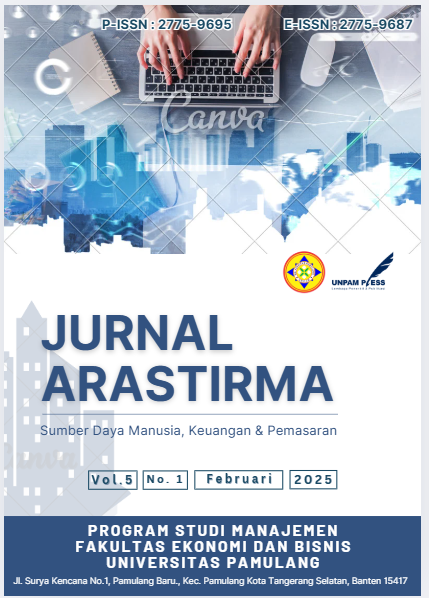Burnout pada Tenaga Kerja Milenial: Menemukan Harapan Keseimbangan Kehidupan-Kerja
DOI:
https://doi.org/10.32493/jaras.v5i1.40048Keywords:
Burnout, Kepuasan Kerja, Kualitas Kehidupan KerjaAbstract
Tujuan. Penelitian ini bertujuan untuk mengisi gap penelitian antara kualitas kehidupan kerja dan burnout dalam meningkatkan kepuasan kerja.
Metode. Penelitian ini dilakukan pada tenaga kerja milenial yang ada di kota Makassar. Sampel penelitian sebanyak 100 responden dan pengambilan sampel menggunakan metode non-probability sampling. Teknik penarikan sampel dalam penelitian ini menggunakan purposive sampling. Teknik pengumpulan data yang dilakukan dengan menggunakan kuesioner. Metode analisis data yang digunakan adalah dengan analisis analissi regresi linier berganda dengan menggunakan aplikasi SPSS versi 25.
Hasil. Hasil penelitian menunjukkan bahwa kualitas kehidupan kerja berpengaruh terhadap kepuasan kerja, burnout berpengaruh terhadap kepuasan kerja, serta kualitas kehidupan kerja dan burnout berpengaruh terhadap kepuasan kerja.
Implikasi. Generasi milenial lebih banyak menggunakan dan mendapatkan informasi melalui media sosial dengan memanfaatkan teknologi dan informasi. Selain itu, generasi ini melibatkan pikiran dan jiwa mereka dalam melakukan sebuah pekerjaan sehingga mereka tumbuh dengan adanya sebuah peningkatan akan pengakuan diri, bersifat sosial, dan memiliki ekspektasi yang tinggi terhadap diri mereka sendiri dan orang lain.
References
Abadi, R. R., Nursyamsi, I., & Syamsuddin, A. R. (2020). Effect of Quality of Work-Life and Employee Engagement towards Job Satisfaction and Employee Performances at PT. Indofood CBP Sukses Makmur, Tbk. Makassar Branch. Global Scientific Journal, 8(8), 2527–2539.
Arief, N. R., Purwan, D., & Saptono, A. (2021). Effect of Quality Work of Life (QWL) and Work-Life Balance on Job Satisfaction through Employee Engagement as Intervening Variables. The International Journal of Social Sciences World (TIJOSSW), 3(1), 25–269.
Aruldoss, A., Kowalski, K. B., & Parayitam, S. (2021). The relationship between quality of work life and work-life-balance mediating role of job stress, job satisfaction and job commitment: evidence from India. Journal of Advances in Management Research, 18(1), 36–62. https://doi.org/10.1108/JAMR-05-2020-0082.
Ashrafi, Z., Ebrahimi, H., Khosravi, A., Navidian, A., & Ghajar, A. (2018). The Relationship Between Quality of Work Life and Burnout: A Linear Regression Structural-Equation Modeling. Health Scope, 7(1), 1–7. https://doi.org/10.5812/jhealthscope.68266.
Burch, A. R. (2014). Pursuing Information: A Conversation Analytic Perspective on Communication Strategies. Language Learning, 64(3), 651–684. https://doi.org/10.1111/lang.12064.
Camelie, N. P., Karyatun, S., & Digdowiseiso, K. (2023). Analysis of Work Motivation, Work Discipline, Job Satisfaction and Job Loyalty to Employee Performance of PT. Matahari Department Store East Jakarta. Jurnal Syntax Admiration, 4(4), 679–693. https://doi.org/10.46799/jsa.v4i4.875.
Cascio, W. F. (2006). Managing Human Resources: Productivity, Quality of Life, Profits. New York: McGraw-Hill/Irwin.
da Costa, B. R. C., & Pinto, I C. J. F. (2017). Stress, Burnout and Coping in Health Professionals: A Literature Review. Journal of Psychology and Brain Studies. 1(4).
De Meuse, K. P., & Mlodzik, K. J. (2010). A Second Look at Generational Differences in the Workforce: Implication for HR and Talent Management. People & Strategy, 33(2), 51–58.
Dhamija, P., Gupta, S., & Bag, S. (2019). Measuring of job satisfaction: the use of quality of work life factors. Benchmarking: An International Journal, 26(3), 871–892. https://doi.org/10.1108/BIJ-06-2018-0155.
Dhir, S., Dutta, T., & Ghosh, P. (2020). Linking employee loyalty with job satisfaction using PLS–SEM modelling. Personnel Review, 49(8), 1695–1711. https://doi.org/10.1108/PR-03-2019-0107.
García, G. A., Gonzales-Miranda, D. R., Gallo, O., & Roman-Calderon, J. P. (2019). Employee involvement and job satisfaction: a tale of the millennial generation. Employee Relations: The International Journal, 41(3), 374–388. https://doi.org/10.1108/ER-04-2018-0100.
Ghozali, I. (2017). Aplikasi Analisis Multivariate dengan Program SPSS. Semarang: Badan Penerbit UNDIP.
Gibson, J. L., Ivancevich, J. M., & Donnelly, J. H. (2005). Organization: Perilaku, Struktur, Proses. Jakarta: Binarupa Aksara.
Haeruddin, M. I. M., Akbar, A., Dipoatmodjo, T. S. P., Kurniawan, A. W., & Abadi, R. R. (2022). The Toxicity of our City: The Effect of Toxic Workplace Environment on Employee’s Performance. International Journal of Social Science and Business, 6(2), 183–190. https://doi.org/10.23887/ijssb.v6i2.45297.
Haeruddin, M. I. M., Asri, A., Firdaus, F., Mustafa, M. Y., Abraham, F. P. A. P., & Haeruddin, M. I. W. (2022). Running’ with the Devil: A Study on Athletes’ Compensation and Turnover Intention. Ann Appl Sport Sci, 10(1), 1–8.
Heidarie, A., Azkary, P., Sara, S., & Bahman, G. (2012). Relationship between Quality of Work-life, Organizational Health and Commitment with Job Satisfaction. Life Science Journal, 9(3).
Indra, F. J., & Rialmi, Z. (2022). Pengaruh Work-Life Balance, Burnout, dan Lingkungan Kerja Terhadap Kepuasan Kerja Karyawan (Studi Kasus Pada Karyawan PT Meka Eduversity Komunikasi). Jurnal Madani: Ilmu Pengetahuan, Teknologi, Dan Humaniora, 5(2), 90–99. https://doi.org/10.33753/madani.v5i2.223.
Jabeen, F., Friesen, H. L., & Ghoudi, K. (2018). Quality of work life of Emirati women and its influence on job satisfaction and turnover intention. Journal of Organizational Change Management, 31(2), 352–370. https://doi.org/10.1108/JOCM-01-2017-0016.
Kabir, M. A. Al, & Rahman, M. (2019). Effects of Work Life Balance on Employee Loyalty in Private Commercial Banks of Bangladesh. Journal of Economics and Sustainable Development, 10(14), 178–191.
Kasraie, S., Parsa, S., Hassani, M., & Ghasem-Zadeh, A. (2014). The Relationship between Quality of Work Life, Job Stress, Job Satisfaction and Citizenship Behavior in Oshnaviyeh Hospital’s Staff. Journal of Patient Safety and Quality Improvement, 2(2), 77–81.
Kim, W. H., Ra, Y.-A., Park, J. G., & Kwon, B. (2017). Role of burnout on job level, job satisfaction, and task performance. Leadership & Organization Development Journal, 38(5), 630–645. https://doi.org/10.1108/LODJ-11-2015-0249.
Lee, J.-S., Back, K.-J., & Chan, E. S. W. (2015). Quality of work life and job satisfaction among frontline hotel employees. International Journal of Contemporary Hospitality Management, 27(5), 768–789. https://doi.org/10.1108/IJCHM-11-2013-0530.
Lu, A. C. C., & Gursoy, D. (2016). Impact of Job Burnout on Satisfaction and Turnover Intention. Journal of Hospitality & Tourism Research, 40(2), 210–235. https://doi.org/10.1177/1096348013495696.
Magni, F., & Manzoni, B. (2020). Generational Differences in Workers’ Expectations: Millennials Want More of the Same Things. European Management Review, 17(4), 901–914. https://doi.org/10.1111/emre.12405.
Mardikaningsih, R., & Sinambela, E. A. (2022). Impact of Burnout and Stress on Employee Satisfaction in Work. International Journal of Service Science, Management, Engineering, and Technology, 2(1), 21–25.
Maslach, C., Schaufeli, W. B., & Leiter, M. P. (2001). Job Burnout. Annual Review of Psychology, 52(1), 397–422. https://doi.org/10.1146/annurev.psych.52.1.397.
Ninaus, K., Diehl, S., & Terlutter, R. (2021). Employee perceptions of information and communication technologies in work life, perceived burnout, job satisfaction and the role of work-family balance. Journal of Business Research, 136, 652–666. https://doi.org/10.1016/j.jbusres.2021.08.007.
Priyono, & Marnis. (2008). Manajemen Sumber Daya Manusia. Sidoarjo: Zifatama Publisher.
Rafsanjani, F., Nursyamsi, I., & Pono, M. (2019). Pengaruh Work-Life Balance Terhadap Kinerja Karyawan Dengan Stres Kerja Dan Kepuasan Kerja Sebagai Variabel Intervening. Hasanuddin Journal of Business Strategy, 1(4), 37–42.
Robbins, S. P. (2001). Perilaku Organisasi: Konsep, Kontroversi, Aplikasi (A. H. Pudjaatmaka & B. Molan, Eds.). Jakarta: Prenhallindo.
Safari, I. (2020). A Study on the Relationship Between Burnout and Job Satisfaction of Iranian EFL Teachers Working in Universities and Schools. Journal on Efficiency and Responsibility in Education and Science, 13(4), 164–173. https://doi.org/10.7160/eriesj.2020.130401.
Sekaran, U., & Bougie, R. (2016). Research Methods for Business: A Skill-Building Approach (7th Edition). West Sussex: Wiley & Sons.
Setiyadi, Y. W., & Wartini, S. (2016). Pengaruh Kualitas Kehidupan Kerja terhadap Kinerja Karyawan dengan Kepuasan Kerja sebagai Variabel Intervening. Management Analysis Journal, 5(4), 315–324.
Srivastava, S., Misra, R., & Madan, P. (2019). ‘The Saviors Are Also Humans’: Understanding the Role of Quality of Work Life on Job Burnout and Job Satisfaction Relationship of Indian Doctors. Journal of Health Management, 21(2), 210–229. https://doi.org/10.1177/0972063419835099.
Stephens, D. O. (2021). Strategies to Engage Millennial Employees (A Multiple Case Study). Open Journal of Business and Management, 9(2), 618–658. https://doi.org/10.4236/ojbm.2021.92033.
Subiyono, K., Susanti, I. H., & Hanum, F. (2022). Hubungan Burnout dengan Kepuasan Kerja Perawat di ruang Rawat Inap RSU WH. SENTRI: Jurnal Riset Ilmiah, 1(1), 215–222. https://doi.org/10.55681/sentri.v1i1.223.
Tarcan, G. Y., Tarcan, M., & Top, M. (2017). An analysis of relationship between burnout and job satisfaction among emergency health professionals. Total Quality Management & Business Excellence, 28(11–12), 1339–1356. https://doi.org/10.1080/14783363.2016.1141659.
Tian‐Foreman, W. (Amy). (2009). Job satisfaction and turnover in the Chinese retail industry. Chinese Management Studies, 3(4), 356–378. https://doi.org/10.1108/17506140911007503.
Unaradjan, D. D. (2019). Metode Penelitian Kuantitatif. Jakarta: Universitas Katolik Indonesia Atma Jaya.
Vuong, B. N., Tung, D. D., Tushar, H., Quan, T. N., & Giao, H. N. K. (2021). Determinates of factors influencing job satisfaction and organizational loyalty. Management Science Letters, 11(1), 203–212. https://doi.org/10.5267/j.msl.2020.8.014.
Wexley, K. N., & Yukl, G. A. (1992). Perilaku Organisasi dan Psikologi Personalia. Jakarta: Rineka Cipta
Downloads
Published
How to Cite
Issue
Section
License
Copyright (c) 2025 Ridfan Rifadly Abadi, Rahmat Riwayat Abadi, M. Ikhwan Maulana Haeruddin, Nurul Fadilah Aswar, Annisa Paramaswary Aslam

This work is licensed under a Creative Commons Attribution 4.0 International License.
Penulis yang menerbitkan jurnal ini menyetujui persyaratan berikut:
Penulis memiliki hak cipta artikel dan menyerahkan kepada jurnal hak publikasi pertama dengan karya yang secara simultan dilisensikan di bawah di bawah persyaratan Atribusi 4.0 Internasional (CC BY 4.0)
 yang memungkinkan orang lain untuk berbagi karya dengan pengakuan kepengarangan karya dan publikasi awal dalam jurnal ini.
yang memungkinkan orang lain untuk berbagi karya dengan pengakuan kepengarangan karya dan publikasi awal dalam jurnal ini.Penulis dapat masuk ke dalam pengaturan kontrak tambahan yang terpisah untuk distribusi non-eksklusif versi jurnal yang diterbitkan dari karya tersebut (misalnya, mempostingnya ke repositori institusional atau menerbitkannya dalam sebuah buku), dengan pengakuan atas karya awalnya publikasi dalam jurnal ini.
Penulis diizinkan dan didorong untuk memposting pekerjaan mereka secara online (misalnya, dalam repositori institusional atau di situs web mereka) sebelum dan selama proses pengajuan, karena dapat menyebabkan pertukaran yang produktif, serta kutipan yang lebih awal dan lebih besar dari karya yang diterbitkan (Lihat The Effect of Open Access).







